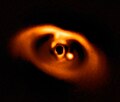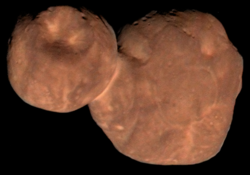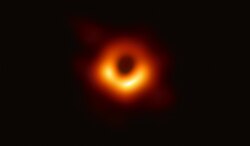Discovery and nomenclature
The planet was discovered by a team of astronomers led by Coel Hellier, who published their findings in November 2019, alongside the detection of three other planets, designated WASP-184b, WASP-185b, and WASP-192b. The four planets were all found through photometric analysis of astronomical transit data collected by WASP-South, hence the "WASP-" prefix. For WASP-178b, data was gathered over the course of eight years between May 2006 and August 2014, which was combined with follow-up observations by the CORALIE spectrograph and EulerCam, which are both part of the Swiss 1.2-metre Leonhard Euler Telescope. [1]
Another team, headed by Romy Rodríguez Martínez, independently announced discovering the planet in December 2019 as part of the Kilodegree Extremely Little Telescope (KELT) survey, labeling it KELT-26b. The host star was photometrically observed by the KELT-South telescope for two years between September 2013 and September 2015, identifying the object as a planetary candidate. Further observations confirmed the exoplanet, which were made by TESS, the Perth Exoplanet Survey Telescope (PEST), and the CHIRON spectrograph on the SMARTS 1.5 m telescope, located at the Cerro Tololo Inter-American Observatory (CTIO). [2] The planet was the 26th and final planet discovered by the KELT survey before it was decommissioned in 2020. [5]
Earlier designations of the host star include CD−42° 10057 in the Cordoba Durchmusterung catalogue and HD 134004 in the Henry Draper catalogue. [6]
Physical properties
The planet orbits its host star every 3.34 days at a distance of 0.0558 AU (8,350,000 km), a mere one-seventh the radius of Mercury's orbit. This proximity to its host star, 20 times more luminous than the Sun, heats its atmosphere up to a white-hot equilibrium temperature of 2,470 K (2,200 °C; 3,990 °F), comparable to the boiling point of silver (2,162 °C [7] ). Due to the intense irradiation, some of the highest even among the ultra-hot Jupiters, [8] the planet's outer layers are inflated to an enormous 1.81 RJ [1] or 1.940 RJ, [2] making it one of the largest planets discovered so far alongside other hot Jupiters such as WASP-12b and Ditsö̀. This also means that the planet has a low density of 0.37 g/cm3 [1] or 0.238 g/cm3, [2] or about as light as cork (0.24 g/cm3 [9] ).
The planet's geometric albedo was measured to be between 0.1 and 0.35 by utilizing CHEOPS photometry [10] and was then further constrained to be below 0.23, [8] implying that it has a poorly reflective surface typical of gas giants. [10]
Atmosphere
The dayside temperature of WASP-178b is calculated at 2,250–2,750 K, [10] which is sufficient to evaporate silicate rock, [4] and above 2,500 K, break down hydrogen molecules into individual atoms. [10] The planet's tidal locking causes the heated daylight side's atmosphere to blow across to the nighttime side at speeds of 2,000 miles per hour (3,200 km/h). [4] On the nightside of the planet, the atomic hydrogen recouples back into molecular H2, [10] and minerals that evaporated on the dayside may cool and condense into rock that pours down from clouds as rain. [4]
In 2022, the discovery of silicon monoxide was reported on WASP-178b, the first time the compound was detected in an exoplanet, and consistent with theoretical predictions of silicate minerals at high temperatures. [11] A follow-up study in 2024, however, concluded that the atmosphere is more likely dominated by ionized magnesium and iron rather than silicon monoxide. [12]
Emission signals from the dayside of the planet as well as the result of eclipse observations strongly suggest the presence of an atmospheric super-rotation and indicate that the chemical composition of the dayside atmosphere may be uneven. [8]
Host star
The host star, WASP-178, is a likely Am star [1] and possibly a Delta Scuti variable, [2] with a spectral type of A1IV-V meaning it is in between being a main sequence star and a subgiant. The star is comparable to Sirius A in mass and radius, but slightly cooler, older, and less luminous. It is about twice as massive as the Sun and has a radius of 1.67 [1] or 1.80 [2] R☉, with an effective temperature of roughly 9,000 K. A 2019 estimate of 9350±150 K makes WASP-178 the second-hottest host to a hot Jupiter ever discovered, behind KELT-9 (10,170 K) and ahead of MASCARA-2 (8,980 K), [1] though a lower estimate (8,640 K) provided by another paper [2] may put it below MASCARA-2. The star is around 20 times brighter than the Sun and is 430+310
−250 million years [2] old.
This page is based on this
Wikipedia article Text is available under the
CC BY-SA 4.0 license; additional terms may apply.
Images, videos and audio are available under their respective licenses.



